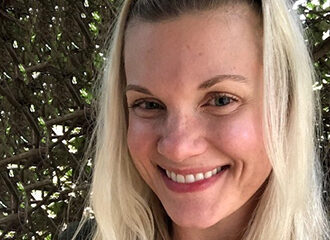Written by: Megan McIntire, LCMHC
Professional Relations Regional Manager, The Renfrew Center
Overview

Now, almost all of The Renfrew Center locations, including the residential campuses, and outpatient sites are offering in-person treatment again. However, Renfrew’s commitment to those clients who are unable to attend in person remains. In addition to offering in-person programming, Renfrew now also offers Renfrew@Home.
What is Renfrew@Home and How Can I Start?
The first step is for a client to call and schedule an assessment. During the assessment, which is a 1-2 hour Zoom call, the Clinical Assessor works with the client to determine what level of care is appropriate and if Renfrew@Home best meets their needs. Once the client completes the assessment and gets medical clearance, they can begin.
On their first day of treatment, each client completes orientation. A clinician talks the client through the structure and philosophy of the program, logistics, and expectations for participation. A client must have wi-fi, a device with audio/video capabilities (such as a cell phone or laptop computer), and a private space to preserve confidentiality. The client is then provided with a secure log-in to join virtual, HIPAA- complaint sessions from the comfort of their own home. Much like a Zoom call, clients can see and communicate with each other, as well as the facilitator during group programming.
In addition to group sessions, clients engage in individual therapy, nutrition therapy, expressive therapies, psychiatric evaluations and follow ups, medication management (if needed), psychoeducation, and supported meals, all in collaboration with a dedicated treatment team. Much like in-person treatment, clients learn the skills to navigate difficult emotions and reappraise beliefs about food, weight, and size by eliminating the socially constructed “good” and “bad” labels often assigned to foods and by discovering how all foods can fit into a value-driven life. When compared to clients receiving in-patient treatment, our research shows that clients in virtual programming experience the same decreases in eating disorder symptoms, experiential avoidance, and anxiety.
Families, partners, and other supports may also engage in treatment through virtual family sessions, and family support groups, where participants learn how to best support their loved one through recovery. These sessions focus on building confidence, increasing empathy, gaining clarity about eating disorders, and creating opportunities to practice the same skills of emotional awareness and acceptance that their loved ones are learning in treatment.
How Long Does Renfrew@Home Last?
Depending on the severity of the symptoms, how long a client has been struggling, and if the client is experiencing medical complications as a result of their eating disorders, a client may be recommended for inpatient, residential, day treatment (aka partial hospitalization), or IOP (intensive outpatient program). Clients typically attend day treatment for 4-6 weeks, and IOP for 6-8 weeks. Once the client completes program, it is recommended that they continue to have weekly sessions with their outpatient team, as well as engage in a weekly aftercare group. Because eating disorders thrive in isolation, it is important for clients to maintain support for long-term recovery.
How Can Renfrew@Home Help Me?
#1: It’s more accessible
Virtual treatment helps people who don’t have access to quality care nearby to engage in treatment for the first time. It’s also a great resource for those who are stepping down from residential care, increasing the likelihood that they stay within the same treatment program, leading to stronger continuity of care.
#2: It still offers human connection
Renfrew@Home offers specialized “tracks” to tailor programming to each client’s individual needs. This includes trauma tracks, adolescent programming, substance use, and more. This allows clients to connect with other clients who experience similar struggles, creating opportunities for deeper connection. Our research shows no difference in the relational connection to the treatment team between clients who receive virtual and those who receive in-person treatment.
#3: You’re always in a safe place
Renfrew@Home softens the discomfort of entering treatment by allowing clients to engage from the comfort of their home. Clients still have the opportunity to experience meal support, while prepping meals in their own kitchen and practicing these new skills in their post-treatment environment. According to our research, 95% of clients would recommend virtual programming to a friend or loved one.
How do you know if Renfrew@Home is right for you?
While virtual treatment is a growing option, some clients may require residential care, or adjunct medical monitoring to ensure their physical safety while recovering from the most acute stages of their eating disorder. Our Clinical Assessors help determine what is the best level of care for yourself or your loved one.
Conclusion
Renfrew now offers 2 evidence-based, complete treatment options: Renfrew@Home and in-person programming. To learn more about these options, and which might be the best fit for you, please call 1-800- Renfrew, and our Admissions team will walk you through these initial steps to recovery.



